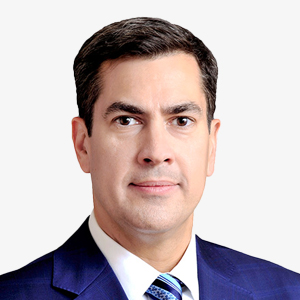Asset Allocation Committee Outlook
Erik L. Knutzen, CFA, CAIA, Co-Chief Investment Officer—Multi-Asset
Jeffrey Blazek, Co-Chief Investment Officer—Multi-Asset
Maya Bhandari, Chief Investment Officer, EMEA—Multi-Asset
That was a tumultuous quarter. Since April, the global economy and markets have faced the U.S. administration’s erratic tariff policy, broader trade tensions, fiscal concerns and flare-ups in geopolitical risk, all resulting in widespread volatility and economic uncertainty. And while many of these catalysts may ultimately have material economic and financial impacts, both macro data and risk markets have shown notable resilience, and “looked through” this uncertainty, a theme that we introduced in our last quarterly outlook. At its heart, “looking through” is an optimistic strategy, one in which we recognize that reinforcing our conviction in our risk posture requires overcoming a degree of skepticism.
Looking back, most equity markets have broadly recovered from the April drawdown with some rising to new highs, while credit spreads have ground back to near their tightest levels of the year. Against this backdrop, weakness in the U.S. dollar and more turbulent moves at the long end of government bond curves have stood out.
Looking ahead, we see several catalysts for further market volatility and economic uncertainty, including rocky trade negotiations, ongoing military conflict in the Middle East, and shifting fiscal policy in the U.S. and other developed economies. However, beyond the short-term effects of these disruptions, we are optimistic in our medium-term outlook for the global economy and risk assets. Our growing confidence in growth prospects and expanding return opportunities across asset classes is supported by continued monetary policy easing, pro-growth fiscal policies in the U.S. and Europe, strong fundamentals in Japan and a strengthening recovery in China.
Growing market breadth is evident in our currency and equity views. This quarter, we are maintaining our U.S. dollar underweight against a broader basket, and have introduced an overweight to emerging markets currencies. In equities, we maintain our preference for non-U.S. developed markets over the U.S. We have also upgraded Japan to overweight from at-target.
In fixed income, a more U.S.-centric view prevails: after capturing favorable valuation moves, we have downgraded non-U.S. developed market bonds to at-target from overweight, preferring to increase our exposure to U.S. fixed income markets where premia are higher and we expect rate cuts more quickly than reflected in market pricing.
At the same time, with tail risks still elevated, we have upgraded commodities to overweight, including gold, which we see as an effective hedge to a growth slowdown, inflation and/or geopolitical event.
As we put pen to paper on this Outlook, President Trump’s One Big Beautiful Bill Act—a $3.4 trillion net fiscal stimulus package—was passed and signed into law, and the administration’s 90-day reciprocal tariff deadline was moved to August 1 from the original date of July 9.
So far, risk markets, as they have done for much of this year, have broadly shrugged off both the deadline extension and the U.S. administration’s threats to impose steep levies on the European Union, Mexico, Brazil, South Korea, Japan and some other trading partners. What happens on tariffs and trade between now and August is highly uncertain, and bouts of volatility remain likely outcomes. However, we believe that, after negotiation, the final tariffs will likely be lower for some, if not most, countries involved, and that a meaningful growth shock to the global economy seems a lower probability.
Economic growth has already taken a hit from the tariffs, but it remains broadly resilient with disinflationary trends continuing to play out across major economies. While inflationary risks, whether from tariffs or potential oil price spikes stemming from the Middle East conflict, continue to stalk markets, we are still seeing broadly improving dynamics. On this basis, we remain confident in our outlook on growth and risk markets for this quarter and over the medium term, a position we believe is supported by several powerful catalysts.
First, most major central banks, including the U.S. Federal Reserve, European Central Bank, Bank of England, The People’s Bank of China, and other emerging market (EM) central banks continue to pursue a course of gradual monetary easing in response to the prevailing trend of disinflation. This accommodative backdrop should help boost flagging global growth rates, bolstering risk asset performance. Candidly, the outlook for the timing of rate cuts remains complex and highly data-dependent. Ultimately, we expect the Fed will focus more on softening labor markets and look past the one-time inflationary effects of tariffs.

Second, ambitious pro-growth fiscal policies in the U.S. and Europe are expected to stimulate demand and improve growth prospects over the medium term. In particular, we expect the pro-business elements of the U.S. tax and spending bill—especially the restoration of beneficial tax treatment for capital investment—and the drive for deregulation to support growth for small and medium-sized businesses and in turn consumers in the U.S. In Europe, and Germany specifically, we have seen a dramatic shift toward significant fiscal spending on defense and infrastructure, which has improved the outlook for above-trend growth in that region.
Third, our outlook for Asia is improving, supported by Japan’s strengthening fundamentals, including solid wage growth and pro-shareholder reforms. Similarly, China’s broad-based economic stabilization, fueled by significant fiscal and monetary stimulus, should position its economy and equity markets for recovery.
Overall, this constructive economic context leads the AAC to maintain a positive medium-term outlook for markets, with some nuance and regional divergence across asset classes.
The Committee’s overweight in global equities remains unchanged from last quarter, and our conviction that we’d see a broadening out in equity performance, articulated at the beginning of the year, remains in place. Earnings and valuation multiples in markets such as Europe and Japan have room to accelerate, supported by strengthening economic fundamentals and solid corporate earnings prospects.
Within the U.S. itself, we’re seeing the Magnificent 7 stocks, long the juggernaut of the S&P 500, underperform, returning 2.6% versus 6.2% for the S&P 500 Index (total returns) during the first half. We remain overweight small and mid-cap stocks, expecting them to outperform relative to large caps (See the Up for Debate section). This view is supported by lower interest rates, deregulation and the beneficial tax treatment contained in the U.S. tax bill. While we continue to see strong prospects for earnings growth from the mega-cap tech sector, valuations remain stretched and we anticipate further convergence with the rest of the market.
We remain at target overall for emerging markets, with a more positive posture on China maintaining our overweight. We have, however, downgraded India to underweight from at-target due to high valuations and weakening macro momentum.
Reflecting our increasingly positive stance on U.S. duration, we have upgraded our view on investment grade fixed income and U.S. TIPS. Our expectation for lower U.S. yields has broader implications, as emerging markets rates typically benefit from rallies in U.S. duration. As such, we have upgraded EM debt and EM currencies to overweight from at-target.
In contrast, we now hold a neutral view on non-U.S. developed market bonds. Yield differentials and relative outperformance—especially European government bonds relative to U.S. Treasuries—have led us to downgrade non-U.S. developed market bonds (including German Bunds) to at-target from overweight. Indeed, we believe expected rate cuts by the Fed should help boost performance of U.S. fixed income, particularly TIPS. On the credit side, we have upgraded our views on high yield corporate bonds to at-target from underweight, reflecting the attractive absolute yield and stable credit fundamentals in the asset class, which has already undergone considerable spread-tightening.
We have tactically upgraded our view on commodities to overweight from at-target, specifically based on our view that gold is an effective hedge against both geopolitical and inflationary risks. While ongoing conflicts in the Middle East may cause short-term volatility in oil prices, we do not expect a sustained surge in inflation from oil unless a severe and prolonged supply disruption occurs.
Within hedged strategies, the AAC maintains its underweight position. However, we acknowledge several favorable market trends that could create opportunities; for example, in equity long/short, intra-stock and intra-sector correlations have fallen to their lowest level in 20 years, which creates a supportive environment for strategies seeking alpha on both the long and short side. We are also seeing a rise in stressed and distressed situations in the real estate sector, a trend we expect to continue evolving over the medium term.
We are maintaining our overweight and at-target positioning on private equity and private debt, reflecting our expectation that deal flow will recover and demand for liquidity solutions will remain strong. Ample financing at attractive levels in both the syndicated loan and private credit markets should support increased deal activity. We also anticipate continued high levels of activity in traditional limited partner secondaries, debt and minority equity recapitalizations, and continuation vehicles.
We, therefore, look out over the next quarter and beyond with some optimism. While trade policy and economic uncertainty are unlikely to be fully resolved this year, we believe there are attractive medium-term opportunities for investors who can look beyond the short-term market volatility.
Questions around the impact of tariffs on economic growth rates and inflation remain, but we believe these unknowns do not create an insurmountable “wall of worry.” In our view, the risk of negative outcomes, such as punitive tariffs, sharply lower earnings downgrades and recession risks, has diminished considerably. This supports our decision to remain overweight risk assets.
Taking a more unbridled optimistic view, if the U.S. adopts a more predictable and growth-friendly policy stance, as we expect, it could serve as a powerful catalyst for renewed economic momentum over the next 12 to 18 months.
Among all the investment themes the Committee discussed, the allocation within U.S. equities, specifically the balance between large caps and small and mid-cap stocks, was one of the most keenly debated.
There are good reasons for that. One such is that even though tactical overweights and underweights have performed well over the last several quarters, the Committee’s overweight to small and mid-caps has underperformed, hurt by elevated interest rates and trade uncertainty.
This naturally raises the question of whether the overweight should remain in place. While some members argued it should be changed, the Committee overall resolved to hold the position due to the range of potentially positive catalysts mentioned earlier.
Importantly, large cap stocks are also supported by several strong drivers, not least the resilience of the U.S economy and solid corporate expectations. However, with valuations at or near all-time highs, the Committee was not persuaded to upgrade their view from their at-target position.























